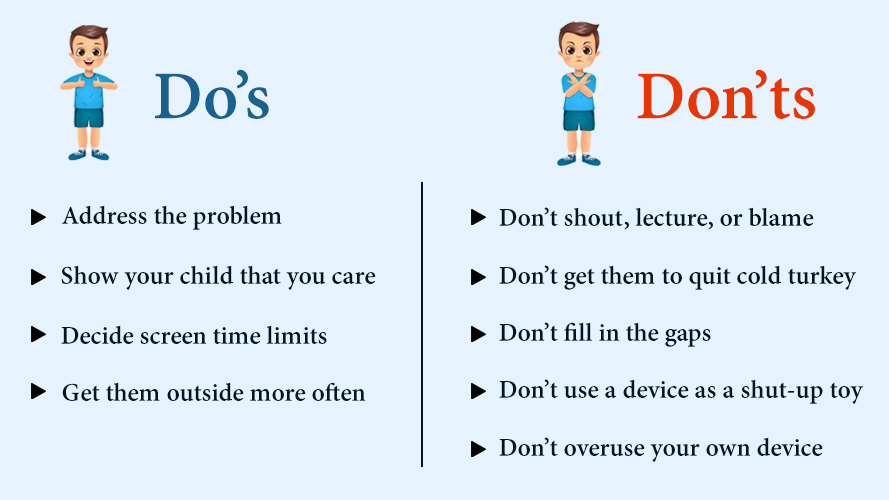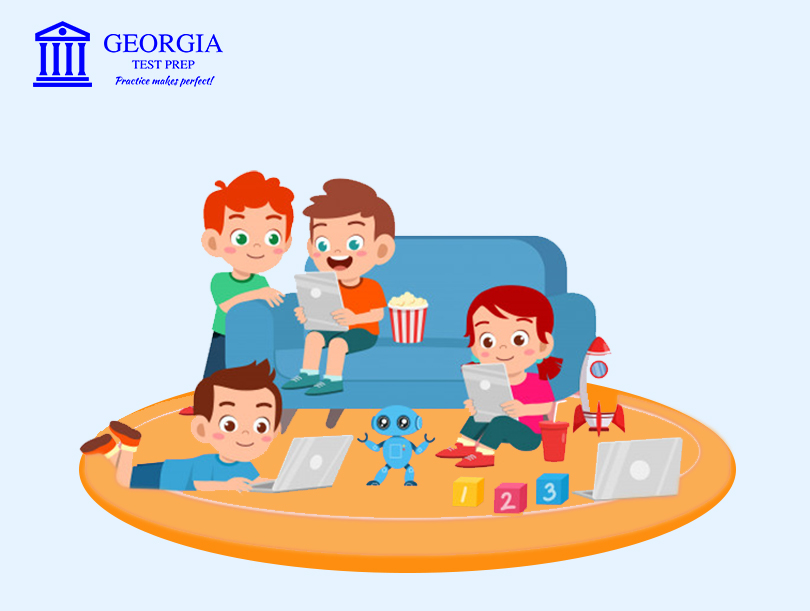Kids these days have it way different from how we had it.
Most notably, they have a tiny rectangle that fits in the palm of their hand that gives them access to all of recorded human history and culture… and this is a gift and a curse!
Poetic musings aside, we do need to talk about a serious problem that many kids born in the digital age may face: technology addiction.
How does Technology Addiction happen?
There is such a thing as too much of a good thing, and this applies to technology as well.
Technology addiction forms the same way all addictions form: through over-reliance on a chemical release. This may apply to you as well.
Essentially, we get a small release of dopamine through many of the actions we do through our technology. When we receive/send a message, when we get new likes on our latest post, when we beat the next level on Candy Crush—all of these actions release dopamine.
The problem is that these actions are so easy and so innocuous that we can get addicted to the dopamine release cycle without even noticing it.
Harmful effects of Technology Addiction
With every experience that we have, neurons are fired in the brain.
Every repeated experience fires the same neural pathways. The more frequently these neural pathways are fired, the stronger they become. This affects the physical structure of the brain. This is why when we practice something a lot we can seemingly do it “without even thinking about it”.
You can begin to see how important this is for a child, because their brains are a relatively fresh slate, and hence highly impressionable.
Areas of the brain that get used more often become stronger. Similarly, areas of the brain that are not regularly used can fall out of practice. These neural pathways can even stop firing at all.
For example, consider the difference between reading a story to your child and letting an app read them a story. In the former, they are forced to process your voice into words, follow the storyline, and create their own visualization. In the latter, they are spoon-fed images and words, they can go back and forth as they please, and it turns out to be a very passive activity for them. It doesn’t exercise their creativity at all.
Some of the common problems exhibited by children who develop a technology addiction are:
- Poor face-to-face communication skills
- Attention deficiency
- Trouble making friends
- Self-isolation
- Aggressive behavior
- Difficulty sleeping
Does my kid have a Technology Addiction?
It can often be hard to pin down. As parents, we may even feel inclined to lie to ourselves about it.
But we have to be vigilant. Look for the following signs of possible dependency on technology in your kids.
- Lack of interest in other activities. They are unable to find entertainment in activities that don’t involve technology. Or they used to enjoy things that they don’t seem to anymore.
- Displaying problematic behavior when they can’t access their devices. They throw excessive tantrums or become uncharacteristically aggressive.
- Displaying withdrawal symptoms when they can’t access their devices. They seem anxious or upset, and might only become calm when they get their devices.
- Constant distraction by technology. You find it difficult to communicate with them or get their attention when they are using their devices, or they always seem to be waiting for the next time they can get online.
- Constant talking about screen-time. When they are not using their devices, they are referring to them in one way or another.
Addressing Technology Addiction in your kids: The DOs and DON’Ts
OK, so you’ve detected a problem. Now how to fix it?
First and foremost, take a step back and realize that you don’t know what it’s like to be in their situation. All of this wonderful technology—smartphones, broadband internet, social media, and so on—came to us at a time when we were already relatively mature. Our kids, on the other hand, were born right into this world. While we knew a pre-digital world and can compare today with that time, kids have no such standard—what they know today is their complete reality.
Be sensitive and kind. Remember to treat them as equals. Coming off a technology addiction is difficult, and there may be moments of strain.
And finally, you will need to be present and set an example.

That being said, let’s get into the DOs and DON’Ts of addressing technology addiction in your kids.
DO #1: Address the problem
The first step is obvious, but approach is everything.
Think about the issue, what the problem is, and what your goals are.
In a two-parent household, both of you must be united and agree on common goals. You probably know what happens if you are not united on an issue—your child takes the soft corner and gets their way.
DO #2: Show your child that you care
When you broach the subject, do not make it sound like a punishment or like you are leveling an accusation. You are bringing it up because you care—that needs to show through.
Children often view questions about their behavior as a condemnation of sorts, so you need to reassure them that this is not the case.
A child who has a technology addiction may feel threatened by this kind of talk, so be prepared for all kinds of emotional outbursts, accusations, and tirades meant to make you feel guilty. This kind of response is natural.
Your best line of defense? Don’t respond to the emotion. Acknowledge their feelings, but stay focused on the issue.
DO #3: Decide screen time limits
Implement limits with kindness, but also with firmness. And remember that there are a number of ways to implement screen time limits.
One way is setting boundaries, like no screen-time during family-time, or before bed.
You can also make a hierarchy of screen-time. For example, allocate some time to educational apps or communal screen time, and reserve the rest for free-time or individual screen-time.
Involve your children in the decision of screen-time limits, but remember to be firm.
DO #4: Get them outside more often
Take them on a walk around the block, or a hike through the woods.
Take them on a trip to the store without their devices.
Whatever you do, get them out.
It doesn’t have to be every day, but build a habit in your kids to spend some time outside without their devices, especially in nature.
DON’T #1: Don’t shout, lecture, or blame
As you are coming from a position of care, refrain from these actions.
It’s difficult for kids to understand that they have a technology addiction. They cannot see the situation from outside of themselves.
This might call on you to show immense patience, but this is better than condemning your child and causing them to build resentment or self-hate.
Bring the conversation to concerns that you have, and highlight those concerns—it might be fatigue, declining grades, giving up hobbies, social withdrawal, etc. Assure them that you will take the journey with them, so they don’t feel alone.
DON’T #2: Don’t get them to quit cold turkey
A sudden transition will feel more like a punishment than anything else, and is likely to exacerbate any withdrawal symptoms.
Take a staggered approach. Outline your ultimate goal with them (say, reducing screen-time to 1 hour per day), and gradually work towards it.
Have regular check-ins with them to ask them how they are doing and to give them encouragement, and also to praise their commitment. A little bit of positive reinforcement can go a long way.
DON’T #3: Don’t fill in the gaps
Your kids may experience a void left by the absence of their devices. Parents sometimes tend to feel a responsibility to then structure their child’s time so that they don’t feel upset or bored.
This amounts to a form of rescuing your child. You don’t need to do that.
Trust your child to deal with the boredom and frustration. Let them figure it out! The experience will give them the opportunity to develop problem-solving skills and resilience.
DON’T #4: Don’t use a device as a shut-up toy
Although this is more of a preventative than a curative measure, it’s worth mentioning.
Don’t use the device as a bargaining chip or a distraction to get unruly children to behave or sit quietly. This is enabling behavior.
DON’T #5: Don’t overuse your own device
As with all other behaviors, the most effective thing you can do to influence your child’s relationship with technology is to set an example.
That might mean overcoming your own desire to keep checking your devices.
If you have designated family time, strictly keep your own devices away. That email from the office can wait, especially if it’s after work hours.
Let your kids see you doing other activities in the evenings. For example, the best way to instill a reading habit in them is to let them see you reading.
Set high standards of device independence for yourself, and your children will follow your lead. This can only be good for both of you.
A technology addiction, like any addiction, is a serious issue. But that doesn’t mean that it should be a cause for panic.
Modern technology is a wonderful ally that enables us to do amazing things when used in moderation.
Keep a vigilant eye on your child’s technology habits, and don’t be afraid to have a difficult conversation if you see signs of a technology addiction.
Also keep an eye on your own technology habits! It will be impossible to get your child to follow your rules if they constantly see you breaking them. This is a journey that you will need to help your child with. You’ll need to lead by example and show a lot of care. But with technology becoming ubiquitous in ways we have never expected, the ability to use technology consciously will help your child immensely.


